A Methodology to Analyze the Presence of Sustainability in Engineering Curricula. Case of Study: Ten Spanish Engineering Degree Curricula
Abstract
1. Introduction
1.1. Motivation and Related Work
- C6: Ability to show awareness of equal opportunities and gender issues.
- C17: Ability to act on the basis of ethical reasoning.
- C23: Ability to act with social responsibility and civic awareness.
- C25: Appreciation of and respect for diversity and multiculturalism.
- C28: Commitment to the conservation of the environment.
- Introducing specific sustainability subjects in the curriculum [24].
- C1: Critical contextualization of knowledge by establishing interrelations with social, economic, environmental, local and/or global problems.
- C2: Sustainable use of resources and prevention of negative impacts on the natural and social environment.
- C3: Participation in community processes that promote sustainability.
- C4: Application of ethical principles related to the values of sustainability in personal and professional behavior.
1.2. Objectives and Research Questions
- To design a methodology and tools to analyze objectively to what extent the competencies related to sustainability are developed in an engineering degree.
- To apply the methodology to a case study: Ten engineering degrees from three universities.
- To analyze the presence of the competencies related to sustainability in the case study using the tools designed in Objective 1.
- To compare the presence of competencies related to sustainability between degrees and universities in the case study.
- Q1:
- To what extent is sustainability present in the engineering degrees of the Spanish university system?
- Q2:
- Do Spanish universities have a defined strategy to develop sustainability in their curricula?
- Q3:
- What competencies related to sustainability are present to a greater or lesser extent in the engineering degrees studied?
- Q4:
- Are the competencies related to sustainability present in the different engineering degrees in a uniform way, or are there differences between the degrees?
2. Materials and Methods
2.1. Methodology
- The engineering sustainability map
- The sustainability presence map
2.2. Case of Study
2.2.1. Sample
- The Bachelor Degree in Electrical Engineering at the UCO and UPC.
- The Bachelor Degree in Informatics Engineering at the UCO, UPC, and UPM.
- The Bachelor Degree in Mechanical Engineering at the UCO and UPC.
- The Bachelor Degree in Design Engineering at UPC.
- The Bachelor Degree in Chemical Engineering at UPM.
- The Bachelor Degree in Industrial-Technologies Engineering at the UPM.
2.2.2. Research Design
3. Results and Discussion
3.1. Q1: To What Extent Is Sustainability Present in the Engineering Degrees of the Spanish University System?
- Universities: University of Córdoba (UCO), Universitat Politècnica de Catalunya-BarcelonaTech (UPC), and Universidad Politécnica de Madrid (UPM).
- Degrees: Bachelor Degree in Electrical Engineering (BDEE), Bachelor Degree in Informatics Engineering (BDIE), Bachelor Degree in Mechanical Engineering (BDME), Bachelor Degree in Design Engineering (BDDE), Bachelor Degree in Chemical Engineering (BDCHE), and Bachelor Degree in Industrial-Technologies Engineering (BDITE).
3.2. Q2: Do Spanish Universities Have a Defined Strategy to Develop Sustainability in Their Curricula?
3.3. Q3: What Competencies Related to Sustainability Are More and Less Present in the Engineering Degrees Studied?
- The number (N) of different engineering degrees in which the competency is developed at that domain level. As can be seen, N ≠ 0 in all cases, since none of the rows in Table 2 contain only zeros. From the data in Table 3, it appears that at least two degrees of those studied (note that the minimum value of N is N = 2) are developing some learning result of any domain level for any competency.
- The percentage of engineering degrees that do not develop any learning outcome of that level (% not LO). For example, the domain level L1 of the competency unit C1.H.2 (is creative and innovative) is not present in 70% of the degrees, since only three of the ten degrees studied (N = 3) develop learning outcomes in this domain level (the BDEE of the UPC, the BDIE of the UPM, and the BDDE of the UPC, as shown in Table 2).
- The percentage of map cells, corresponding to a competency unit, that are not developed by any engineering degree (% not CU, percentage of cells containing zeros in each competency unit in Table 2).
- The percentage of map cells, corresponding to a competency, that are not developed by any engineering degree (% not C, percentage of cells containing zeros in each competency in Table 2).
3.4. Q4: Are the Competencies Related to Sustainability Present in the Different Engineering Degrees in a Uniform Way, Or Are there Differences between the Degrees?
3.5. Limitations of This Work and Future Work
4. Conclusions
Author Contributions
Funding
Acknowledgments
Conflicts of Interest
Glossary
| UCO | University of Córdoba |
| UPC | Universitat Politècnica de Catalunya-BarcelonaTech |
| UPM | Universidad Politécnica de Madrid |
| BDEE | Bachelor Degree in Electrical Engineering |
| BDIE | Bachelor Degree in Informatics Engineering |
| BDME | Bachelor Degree in Mechanical Engineering |
| BDDE | Bachelor Degree in Design Engineering |
| BDCHE | Bachelor Degree in Chemical Engineering |
| BDITE | Bachelor Degree in Industrial-Technologies Engineering |
Appendix A
- C1: Critical contextualization of knowledge by establishing interrelations with social, economic, environmental, local and/or global problems.
- C2: Sustainable use of resources and prevention of negative in the natural and social environment.
- C3: Participation in community processes that promotes sustainability.
- C4: Application of ethical principles related to the values of sustainability in personal and professional behaviour.
- H: Holistic
- EV: Environmental
- S: Social
- EC: Economic
| Engineering Sustainability Map | |||||
|---|---|---|---|---|---|
| C | D | Competency unit | Domain levels (according to simplified Miller Pyramid ) | ||
| 1. KNOW | 2. KNOW HOW | 3. DEMONSTRATE and DO | |||
| C1 | H | Has a historical perspective (state of the art) and understands social, economic and environmental problems, both locally and globally. | Knows the main causes, consequences and solutions proposed in the literature regarding the social, economic and/or environmental problems, both locally and globally. | Analyzes the different dimensions of sustainability when solving a specific problem related to engineering. | Identifies the main causes and consequences of a problem related to the sustainability that a product or a service related to engineering can have, and is able to relate them to known problems and solutions previously applied. |
| Is creative and innovative. Is able to see the opportunities offered by engineering to contribute to the development of more sustainable products and processes. | Has sufficient knowledge of the concepts of creativity and innovation, and about strategies to develop them. | Reflects on new ways of doing things. Knows how to use techniques that stimulate creativity, the generation of ideas, and manages them in such a way that they become an innovation. Participates actively when used. | Brings new ideas and solutions to a project related to engineering to make it more sustainable, so as to improve the sustainability of products, processes or services. | ||
| C2 | H | Takes into account sustainability in his/her work as an engineer. | Knows the concept of cost of use, direct and indirect, of the products and services of the technologies related to engineering. Knows the strategic role that the technologies related with engineering play in the sustainability of the planet. Knows the concepts of social justice, resource reuse and circular economy. Knows the concept of social economy, the advantages of solidarity, teamwork and cooperation versus competition. Knows the principles of the economy for the common good. | Is capable of assessing the impact (positive and negative) that different products and services related to engineering have in society and in the sustainability of the planet. Knows how to assess the economic viability of a project of the engineering and whether it is compatible with the environmental and social aspects of sustainability. | Is capable of proposing sustainable projects related to engineering taking into account, holistically, the environmental, economic and social aspects. |
| EV | Takes into account the environmental impact of his/her work as an engineer. | Knows technologies of reuse, reduction, recycling and minimization of the natural resources and residues related to a project of engineering. Knows the life cycle of the products related to engineering (construction, use and destruction/dismantling) and the concept of ecological footprint. Knows models for ecological footprint calculation. Knows metrics to measure the environmental impact of a project (e.g., pollutant emissions, resource consumption). | Is aware that products and services related to engineering have an environmental impact throughout its life. Is capable of measuring the environmental impact of the use of technologies related to engineering using appropriate metrics (e.g., pollutant emissions, and resource consumption,.). | Takes into account the environmental effects of the products and services related to engineering in the projects and technological solutions in which he / she participates. Includes in his/her projects indicators to estimate/measure these effects from the resources used by the project (e.g. energy consumption, pollutant emissions, and consumption of resources). Calculates the ecological footprint of an engineering project. | |
| S | Takes into account the social impact of his/her work as an engineer. | Knows the problems associated with accessibility, ergonomics and safety of products and projects of engineering. Knows the problems associated with social justice, equity, diversity and transparency (gender perspective, needs of the most vulnerable groups, strategies against corruption, etc.). Knows the direct and indirect consequences that the products and services related to engineering have on the society. | Knows how to assess the degree of accessibility, ergonomic quality, the level of safety and the impact on society of a product or service related to engineering. Takes into account the rights of people in their work as an engineer. Understands the need to introduce social justice, equity, diversity, transparency (gender perspective, needs of the most vulnerable groups, anti-corruption, etc.) in projects of engineering. Can assess whether an engineering project contributes to improving the common good of society. | Takes into account the aspects of accessibility, ergonomics and security in technological solutions. Takes into account social justice, equity, diversity and transparency (gender perspective, needs of vulnerable groups, combating inequality and corruption, etc.) in his/her projects. Includes in his/her projects indicators to estimate/measure how they improve the common good of society. Is able to maximize the positive impact of his/her professional activity on society. Is capable of designing engineering projects that contribute to improve the common good of society. | |
| EC | Is capable of successfully carrying out the economic management of an engineering project. | Knows basic concepts about organizations. Knows the fundamental points of a business plan. Knows the process of managing a project. Knows project-planning techniques. | Understands the different economic parts of a project: amortizations, fixed costs, variable costs, etc. Analyzes real planning cases and project budgets. | Is able to plan an engineering project (both short and long term) and to prepare a complete budget based on the material and human resources required. Is able to follow economic development of a project and detect deviations from the initial planning. Is capable of carrying out the economic management of an engineering project throughout its useful life. | |
| C3 | H | Identifies when the sustainability of a project can be improved if it is done through community collaborative work. Responsibly performs collaborative work related to sustainability. | Knows the concept of community collaborative work and its implications in the transformation of society. Knows examples of projects that have been successfully implemented with community collaborative work in the field of engineering. Knows the tools of collaborative work in the field of engineering. | Given a project in the field of engineering, that includes a collaborative community work, is able to assess the implications of such work in the sustainability of the project. | Knows how to use collaborative work tools related to engineering projects. |
| C4 | H | Behaves according to the deontological principles related to sustainability. | Knows the deontological principles related to sustainability. He/she is aware that there are laws and regulations related to sustainability in his/her professional field. Knows the concept of social and corporate responsibility in general, and its possibilities and limitations. | Is able to assess the implications of the deontological principles related to sustainability in a project in the field of engineering. | Does not make decisions that contradict the deontological principles related to sustainability. Is capable of proposing solutions and strategies to promote projects in the field of engineering, consistent with these principles. |
References
- Loureiro, S.M.; Pereira, V.L.D.D.; Pacheco, W. Sustainability and sustainable development in engineering education. Rev. Eletron. Gestao Educ. Tecnol. Ambient. 2016, 20, 306–324. [Google Scholar]
- Kates, R.W.; Clark, W.C.; Corell, R.; Hall, J.M.; Jaeger, C.C.; Lowe, I.; McCarthy, J.J.; Schellnhuber, H.J.; Bolin, B.; Dickson, N.M.; et al. Sustainability Science. Science. 2001, 292, 641–642. [Google Scholar] [CrossRef] [PubMed]
- UN. The Millenium Development Goals. Report 2015. Available online: http://www.un.org/millenniumgoals/2015_MDG_Report/pdf/MDG%202015%20rev%20(July%201).pdf (accessed on 13 August 2019).
- UN. Resolution Adopted by the General Assembly on 25 September 2015. Available online: https://undocs.org/en/A/RES/70/1 (accessed on 13 August 2019).
- Giangrande, N.; White, R.M.; East, M.; Jackson, R.; Clarke, T.; Saloff Coste, M.; Penha-Lopes, G. A Competency Framework to Assess and Activate Education for Sustainable Development: Addressing the UN Sustainable Development Goals 4.7 Challenge. Sustainability 2019, 11, 2832. [Google Scholar] [CrossRef]
- Hallinger, P.; Chatpinyakoop, C. A Bibliometric Review of Research on Higher Education for Sustainable Development, 1998–2018. Sustainability 2019, 11, 2401. [Google Scholar] [CrossRef]
- UNESCO. Global Action Programme on Education for Sustainable Development (GAP). Available online: https://en.unesco.org/gap (accessed on 13 August 2019).
- Fien, J.; Maclean, R. Teacher Education for Sustainability. II. Two Teacher Education Projects from Asia and the Pacific. J. Sci. Educ. Technol. 2000, 9, 37–48. [Google Scholar] [CrossRef]
- Molderez, I.; Fonseca, E. The efficacy of real-world experiences and service learning for fostering competences for sustainable development in higher education. J. Clean. Prod. 2018, 172, 4397–4410. [Google Scholar] [CrossRef]
- Stephens, J.C.; Graham, A.C. Toward an empirical research agenda for sustainability in higher education: Exploring the transition management framework. J. Clean. Prod. 2010, 18, 611–618. [Google Scholar] [CrossRef]
- Wright, T. University presidents’ conceptualizations of sustainability in higher education. Int. J. Sustain. High. Educ. 2010, 11, 61–73. [Google Scholar] [CrossRef]
- Tejedor, G.; Segalàs, J.; Rosas-Casals, M. Transdisciplinarity in higher education for sustainability: How discourses are approached in engineering education. J. Clean. Prod. 2018, 175, 29–37. [Google Scholar] [CrossRef]
- Mälkki, H.; Alanne, K.; Hirsto, L. A method to quantify the integration of renewable energy and sustainability in energy degree programmes: A Finnish case study. J. Clean. Prod. 2015, 106, 239–246. [Google Scholar] [CrossRef]
- Mulder, K.F.; Segalàs, J.; Ferrer-Balas, D. How to educate engineers for/in sustainable development: Ten years of discussion, remaining challenges. Int. J. Sustain. High. Educ. 2012, 13, 211–218. [Google Scholar] [CrossRef]
- Brundtland Report. Our Common Future. Report of the World Commission on Environment and Development, United Nations. 1987. Available online: http://www.un-documents.net/wced-ocf.htm (accessed on 13 August 2019).
- Moreno, A.; Lumbreras, J.; Mataix, C.; Perez-Arriaga, I.J. Engineering education for sustainability: A multistakeholder case study on ICT and transportation. Int. J. Eng. Educ. 2013, 29, 1184–1191. [Google Scholar]
- Ben-Zvi-Assaraf, O.; Ayal, N. Harnessing the Environmental Professional Expertise of Engineering Students—The Course: “Environmental Management Systems in the Industry”. J. Sci. Educ. Technol. 2010, 19, 532–545. [Google Scholar] [CrossRef]
- Abdul-Wahab, S.A.; Abdulraheem, M.Y.; Hutchinson, M. The need for inclusion of environmental education in undergraduate engineering curricula. Int. J. Sustain. High. Educ. 2003, 4, 126–137. [Google Scholar] [CrossRef]
- Wilson, D. Exploring the Intersection between Engineering and Sustainability Education. Sustainability 2019, 11, 3134. [Google Scholar] [CrossRef]
- Tuning Project. Available online: http://www.unideusto.org/tuning/ (accessed on 13 July 2019).
- Tuning Project. Available online: http://www.unideusto.org/tuningeu/competences/generic.html (accessed on 13 July 2019).
- Svanström, M.; Palme, U.; Knutson Wedel, M.; Carlson, O.; Nyström, T.; Edén, M. Embedding of ESD in engineering education: Experiences from Chalmers University of Technology. Int. J. Sustain. High. Educ. 2012, 13, 279–292. [Google Scholar] [CrossRef]
- Byrne, E.P.; Desha, C.J.; Fitzpatrick, J.J.; Hargroves, K.C. Exploring sustainability themes in engineering accreditation and curricula. Int. J. Sustain. High. Educ. 2013, 14, 384–403. [Google Scholar] [CrossRef]
- Ceulemans, K.; De Prins, M. Teacher’s manual and method for SD integration in curricula. J. Clean. Prod. 2010, 18, 645–651. [Google Scholar] [CrossRef]
- Sánchez Carracedo, F.; Segalàs, J.; Vidal, E.; Martín, C.; Climent, J.; López, D.; Cabré, J. Improving engineering educators’ sustainability competencies by using competency maps: The EDINSOST project. Int. J. Eng. Educ. 2018, 34, 1527–1537. [Google Scholar]
- Sánchez Carracedo, F.; Soler, A.; Martín, C.; López, D.; Ageno, A.; Cabré, J.; García, J.; Aranda, J.; Gibert, K. Competency Maps: An Effective Model to Integrate Professional Competencies across a STEM Curriculum. J. Sci. Educ. Technol. 2018, 27, 448–468. [Google Scholar] [CrossRef]
- Chiong, K.S.; Mohamad, Z.F.; Abdul Aziz, A.R. Factors encouraging sustainability integration into institutions of higher education. Int. J. Environ. Sci. Technol. 2017, 14, 911–922. [Google Scholar]
- Sánchez Carracedo, F.; Climent, J.; Corbalán, J.; Fonseca i Casas, P.; Garcia, J.; Herrero, J.R.; Rodríguez, H.; Sancho, M.R. A Proposal to Develop and Assess Professional Skills in Engineering Final Year Projects. Int. J. Eng. Educ. 2018, 34, 400–413. [Google Scholar]
- Miñano, R. Estudio de la Integración de la Sostenibilidad en Grados de Ingeniería Industrial. In Proceedings of the 4th International Congress of Educational Sciences and Development, Santiago de Compostela, España, 23–25 June 2016; pp. 29–34. Available online: https://www.congresoeducacion.es/edu_web5/DOC/LIBROCAPITULOS2016.pdf (accessed on 13 August 2019).
- Sinakou, E.; Boeve-de Pauw, J.; Goossens, M.; Van Petegem, P. Academics in the field of Education for Sustainable Development: Their conceptions of sustainable development. J. Clean. Prod. 2018, 184, 321–332. [Google Scholar] [CrossRef]
- Lourdel, N.; Gondran, N.; Laforest, V.; Brodhag, C. Introduction of sustainable development in engineers’ curricula: Problematic and evaluation methods. Int. J. Sustain. High. Educ. 2005, 6, 254–264. [Google Scholar] [CrossRef]
- Hanning, J.; Abelsson, A.P.; Lundqvist, U.; Svanström, M. Are we educating engineers for sustainability? Comparison between obtained competences and Swedish industry’s needs. Int. J. Sustain. High. Educ. 2012, 13, 305–320. [Google Scholar] [CrossRef]
- CRUE. Directrices Para la Sostenibilización Curricular. Available online: https://www.crue.org/Documentos%20compartidos/Declaraciones/Directrices_Sosteniblidad_Crue2012.pdf (accessed on 13 August 2019).
- Sánchez-Carracedo, F.; Ruiz-Morales, J.; Valderrama-Hernández, R.; Muñoz-Rodríguez, J.M.; Gomera, A. Analysis of the presence of sustainability in Higher Education Degrees of the Spanish university system. Stud. High. Educ. 2019. [Google Scholar] [CrossRef]
- Tejedor, G.; Segalàs, J.; Barrón, A.; Fernández-Morilla, M.; Fuertes, M.T.; Ruiz-Morales, J.; Gutiérrez, I.; García-González, E.; Aramburuzabala, P.; Hernández, A. Didactic Strategies to Promote Competencies in Sustainability. Sustainability 2019, 11, 2086. [Google Scholar] [CrossRef]
- Miller, G.E. The assessment of clinical skills/competence/performance. Acad. Med. 1990, 65, S63–S67. [Google Scholar] [CrossRef]
- Ferrer-Balas, D.; Adachi, J.; Banas, S.; Davidson, C.I.; Hoshikoshi, A.; Mishra, A.; Motodoa, Y.; Onga, M.; Ostwald, M. An international comparative analysis of sustainability transformation across seven universities. Int. J. Sustain. High. Educ. 2008, 9, 295–316. [Google Scholar] [CrossRef]
- Naval, C.; García, R.; Puig, J.; Santos, M.A. Ethical and civic education and the social commitment of university students. Encount. Theory Hist. Educ. 2011, 12, 77–91. [Google Scholar] [CrossRef]
- GUNI. Global Universities Network for Innovation, Higher Education in the World 4, Barcelona: GUNI. Higher Education’s Commitment to Sustainability: From Understanding to Action. Available online: http://www.guninetwork.org/articles/higher-educations-commitment-sustainability-understanding-action (accessed on 13 August 2019).
- León, Y. Universidades y Sostenibilidad: Análisis de Actuaciones de Participación en Universidades Españolas y Latinoamericanas. Ph.D. Thesis, University of Córdoba, Córdoba, Spain, 2015. Available online: https://helvia.uco.es/xmlui/bitstream/handle/10396/13164/2015000001208.pdf?sequence=1&isAllowed=y (accessed on 13 August 2019).
- Tilbury, D.; Fellow, M.C. Sustainability in the DNA of the university. Sustain. Mediterr. 2010, 63–64, 9–13. [Google Scholar]
- Tilbury, D. Higher education for sustainability: A global overview of commitment and progress. High. Educ. World. 2011, 4, 18–28. [Google Scholar]
- OECD. The Definition and Selection of Key Competencies. Executive Summary. Resource Document. Available online: https://www.oecd.org/pisa/35070367.pdf (accessed on 13 August 2019).
- Benayas, J. Evaluación de las Políticas Universitarias de Sostenibilidad Como Facilitadoras Para el Desarrollo de los Campus de Excelencia Internacional. Available online: https://www.upc.edu/rsu/ca/la-responsabilitat-social-a-la-upc-1/fitxers/informe-evaluacion-sostenibilidad (accessed on 13 August 2019).
- Sánchez-Carracedo, F.; Álvarez, M.J.; Barrón, A.; Caballero, D.; López, E.; Muñoz, J.M.; Lugo-Muñoz, M.; Sureda, B.; Vidal, E.; Vidal, S. Elaboración de un cuestionario para evaluar el nivel de sostenibilidad de los estudiantes de grados en ingeniería TIC. In Proceedings of the XXIV Jornadas de Enseñanza Universitaria de la Informática (JENUI 2018), Barcelona, España, 4–6 July 2018; pp. 141–148. [Google Scholar]
- Likert, R. A technique for the measurement of attitudes. Arch. Psychol. 1932, 140, 1–55. [Google Scholar]
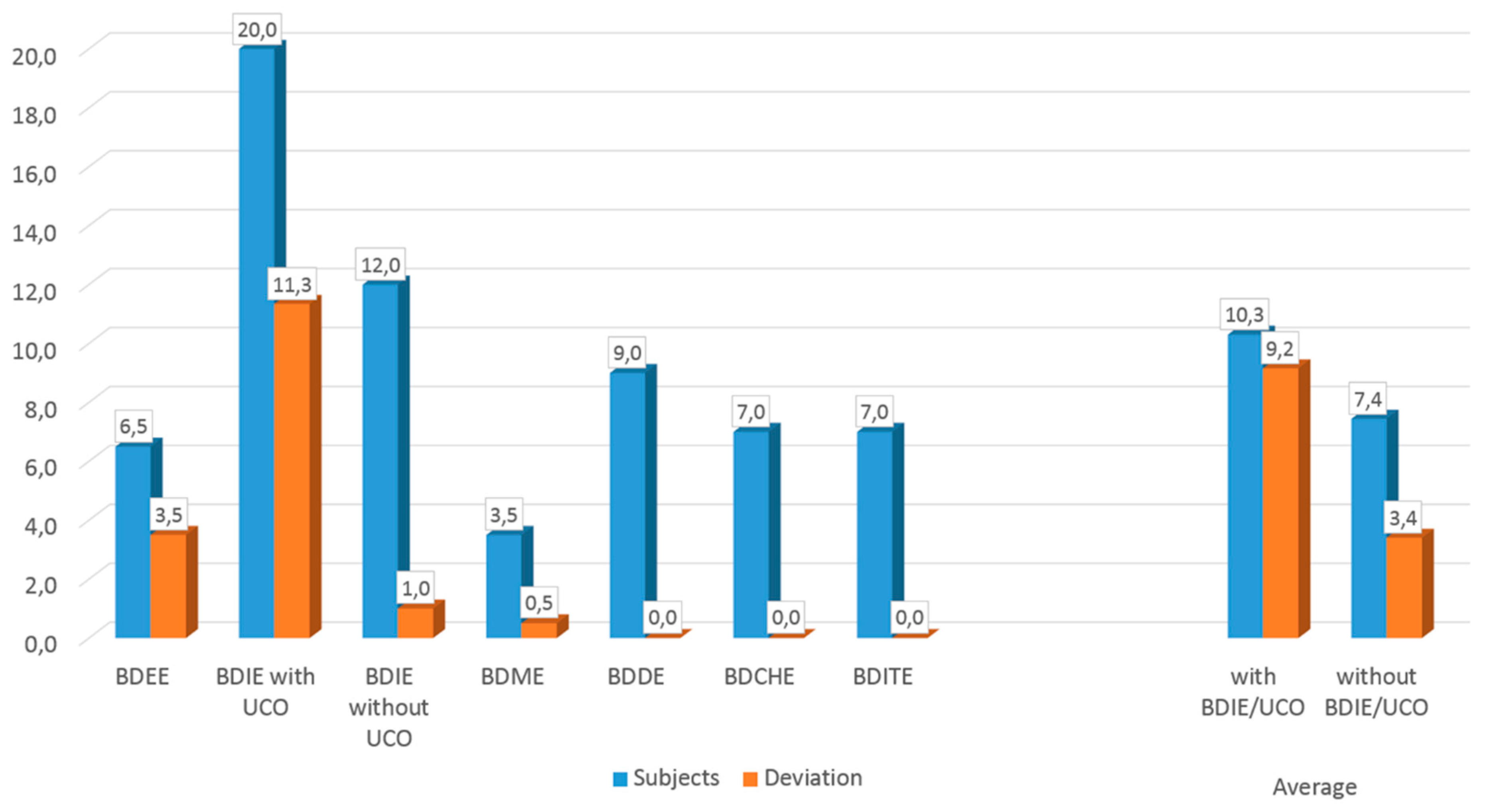
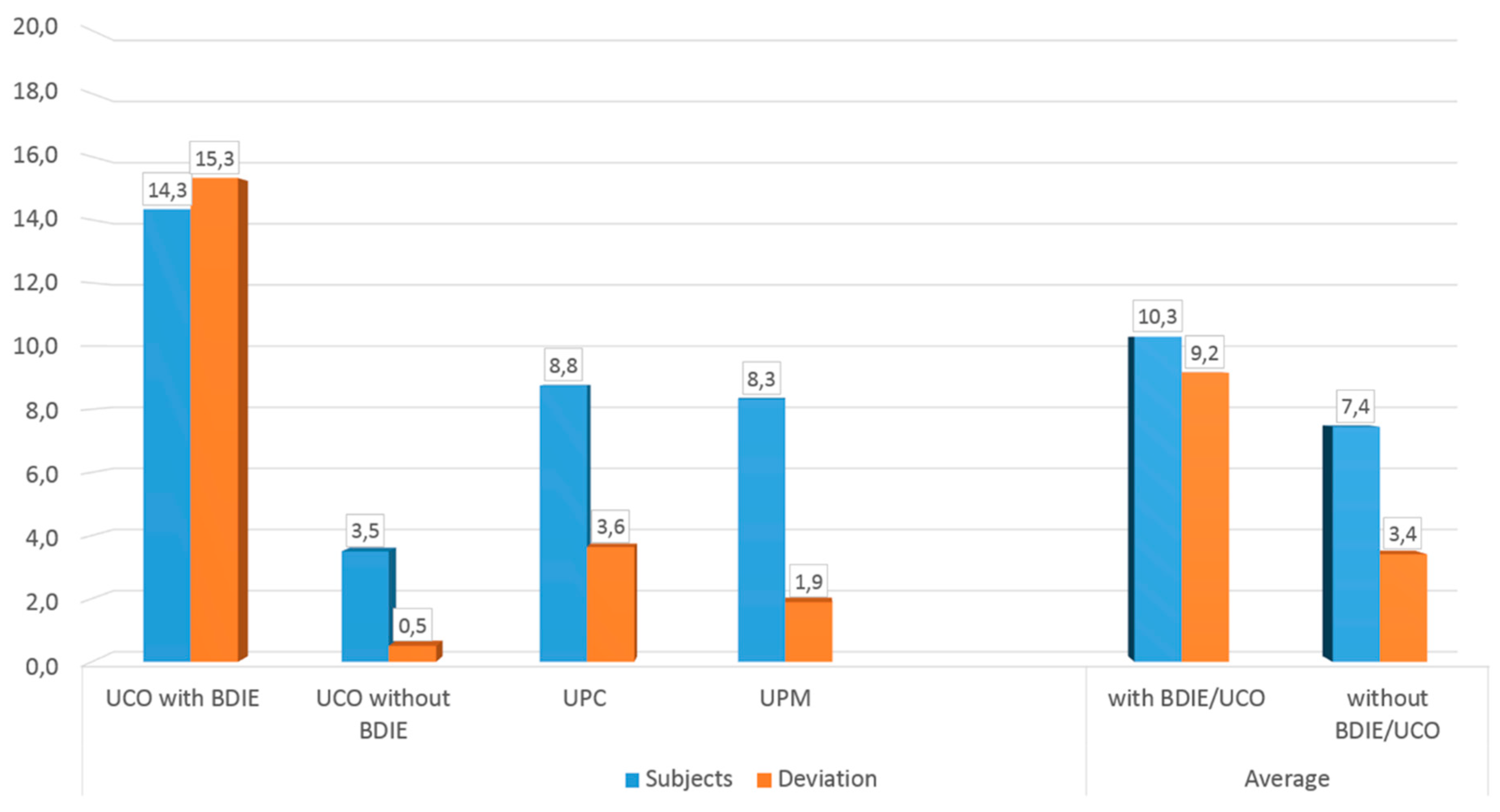
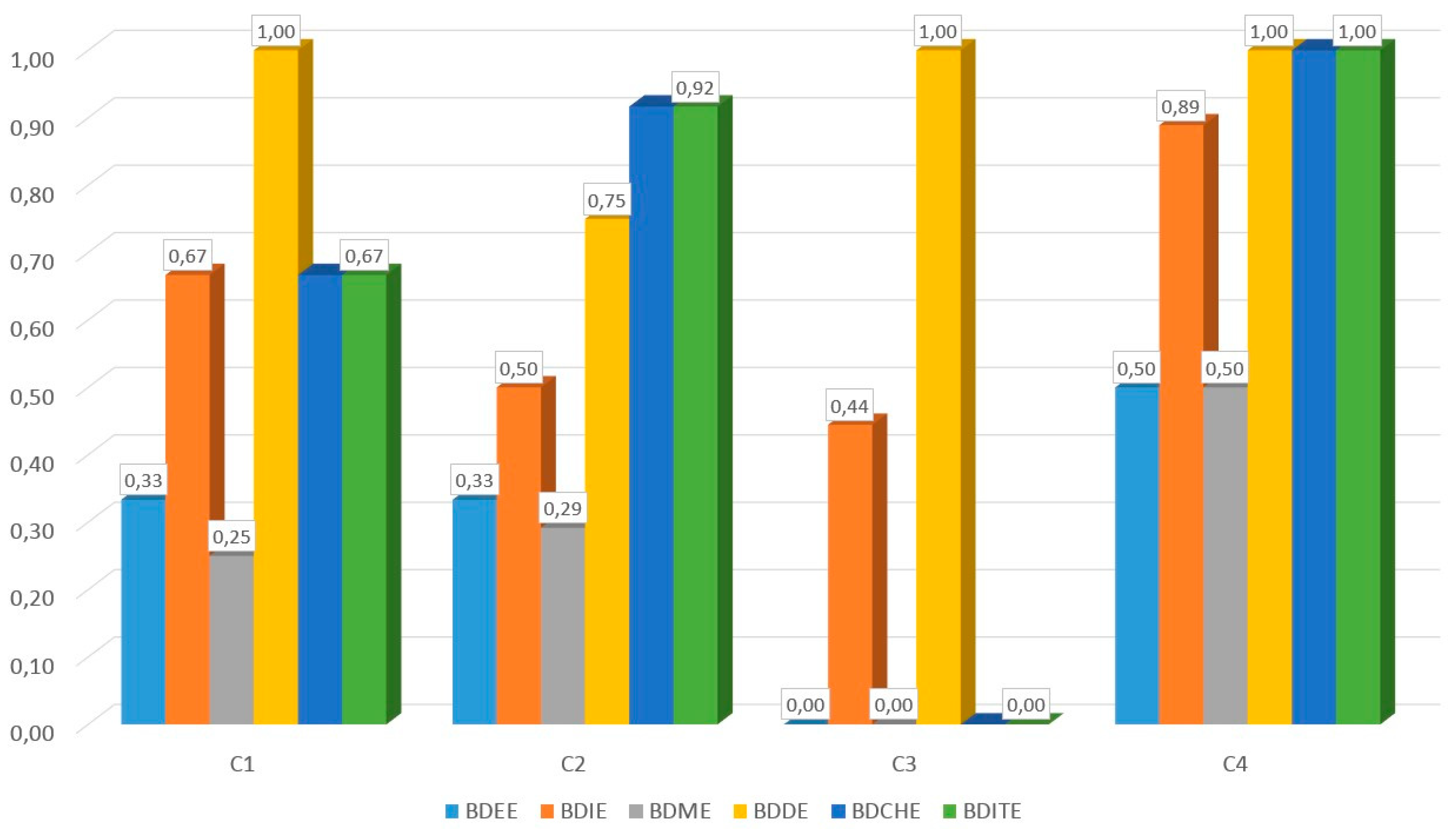

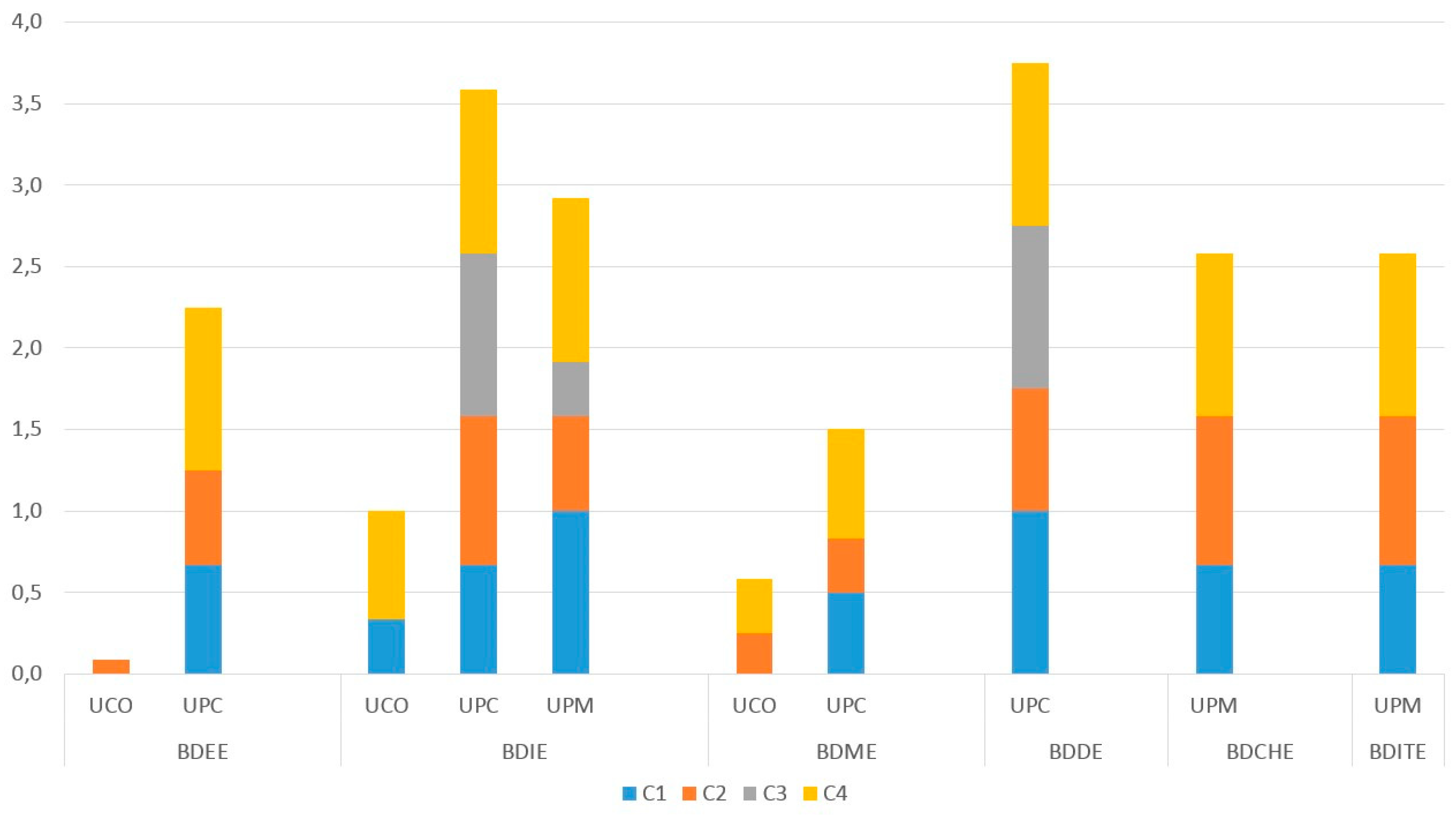
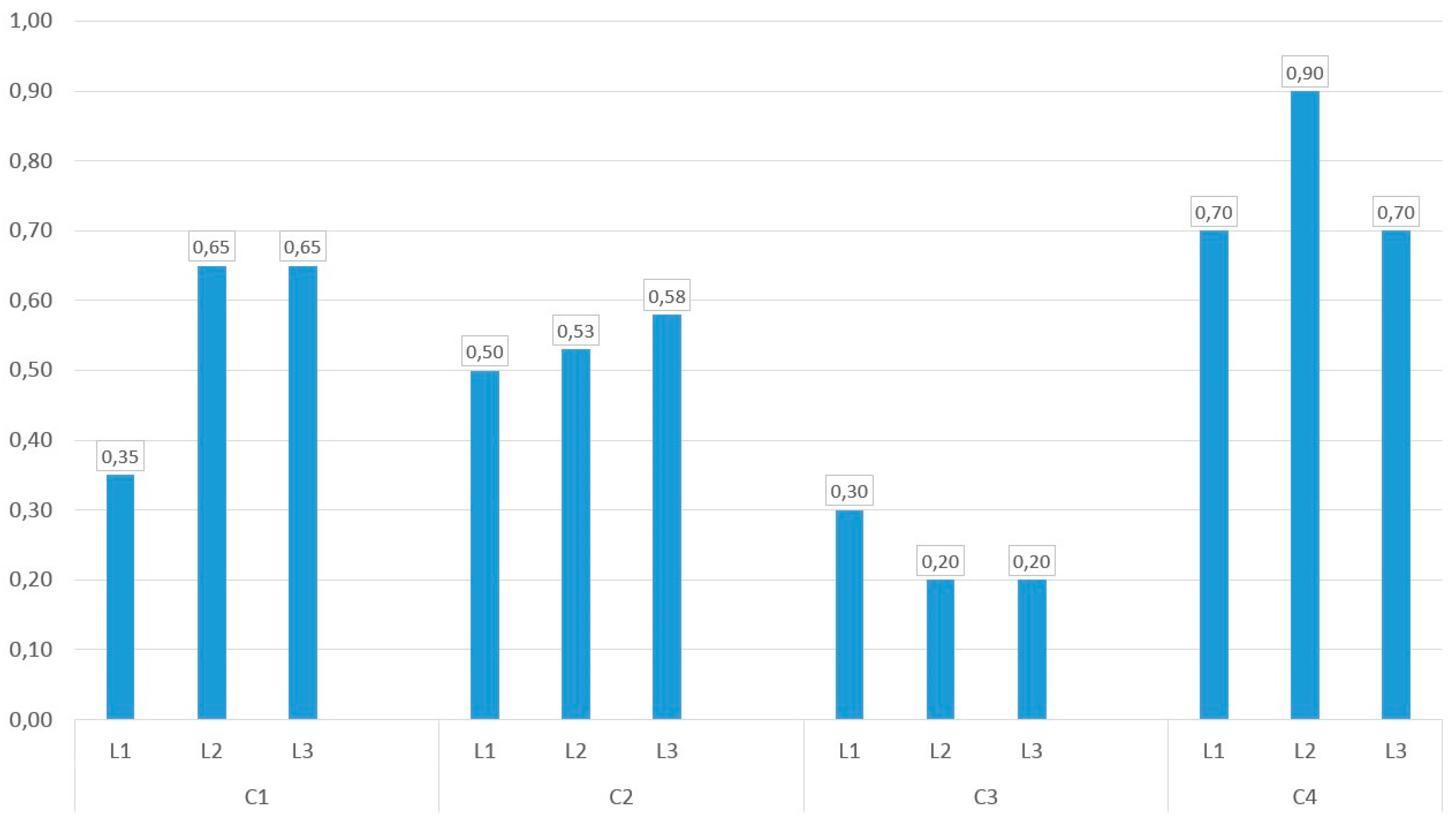
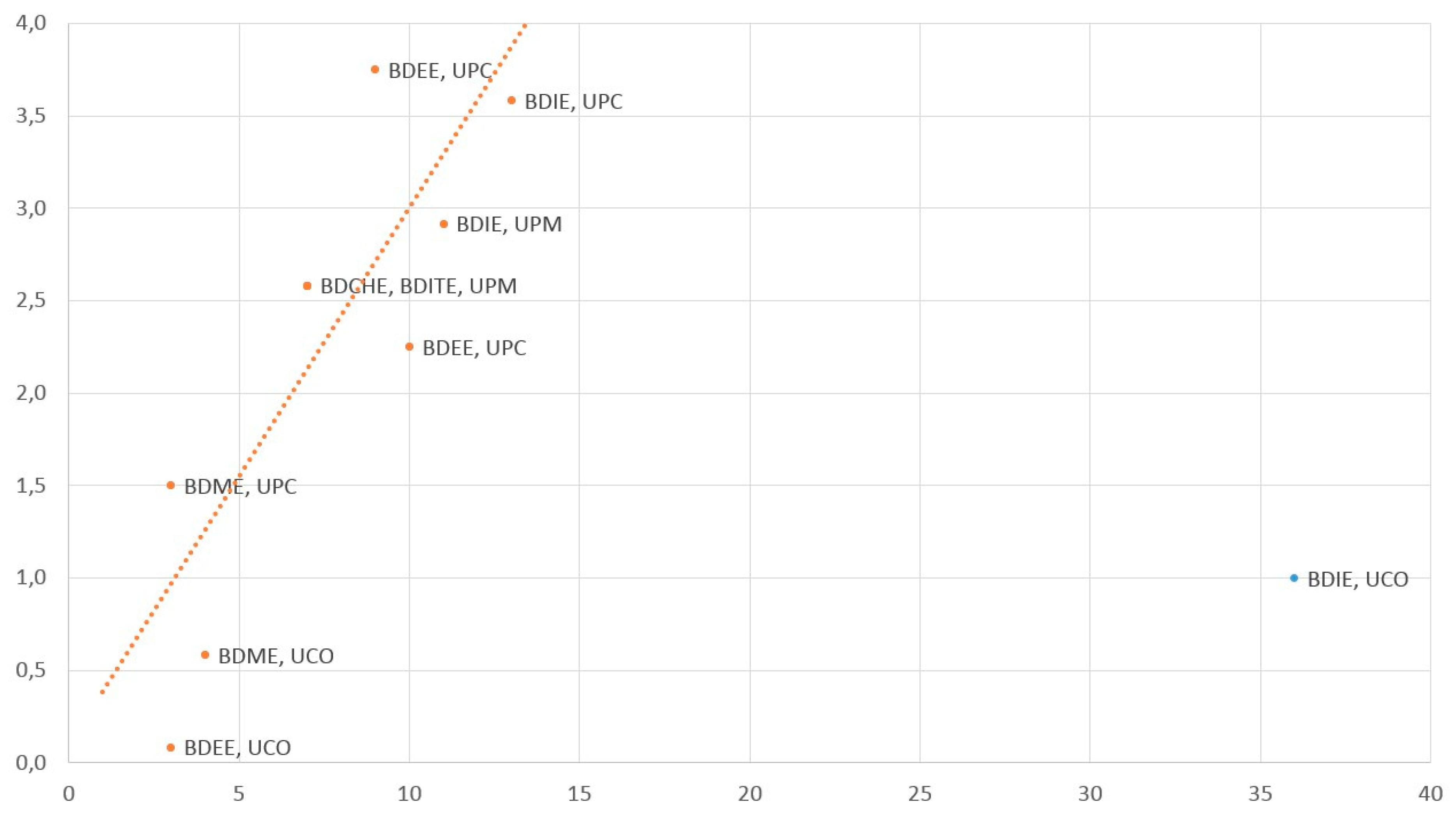
| Competency | Dimension | Competency Units |
|---|---|---|
| C1: Critical contextualization of knowledge | Holistic | C1.H.1. Has a historical perspective (state of the art) and understands social, economic and environmental problems, both locally and globally. |
| C1.H.2. Is creative and innovative. Is able to see the opportunities offered by engineering to contribute to the development of more sustainable products and processes. | ||
| C2: Sustainable use of resources | Holistic | C2.H.1. Takes into account sustainability in his/her work as an engineer. |
| Environmental | C2.EV.1. Takes into account the environmental impact of his/her work as an engineer. | |
| Social | C2.S.1. Takes into account the social impact of his/her work as an engineer. | |
| Economical | C2.EC.1. Is capable of successfully carrying out the economic management of an engineering project. | |
| C3: Participation in community processes | Holistic | C3.H.1. Identifies when the sustainability of a project can be improved if it is done through community collaborative work. Responsibly performs collaborative work related to sustainability. |
| C4: Application of ethical principles | Holistic | C4.H.1. Behaves according to the deontological principles related to sustainability. |
| Degree | BDEE | BDIE | BDME | BDDE | BDCHE | BDITE | |||||
|---|---|---|---|---|---|---|---|---|---|---|---|
| University | UCO | UPC | UCO | UPC | UPM | UCO | UPC | UPC | UPM | UPM | |
| C1: Critical contextualization of knowledge by establishing interrelations with social, economic, environmental, local and/or global problems. | |||||||||||
| C1.H.1 | L1 | 0 | 6 | 0 | 0 | 1 | 0 | 3 | 3 | 0 | 0 |
| L2 | 0 | 3 | 0 | 5 | 1 | 0 | 2 | 3 | 2 | 2 | |
| L3 | 0 | 2 | 6 | 4 | 1 | 0 | 1 | 2 | 2 | 2 | |
| C1.H.2 | L1 | 0 | 1 | 0 | 0 | 2 | 0 | 0 | 2 | 0 | 0 |
| L2 | 0 | 0 | 19 | 3 | 1 | 0 | 0 | 2 | 2 | 2 | |
| L3 | 0 | 0 | 0 | 3 | 1 | 0 | 0 | 1 | 3 | 3 | |
| C2: Sustainable use of resources and prevention of negative impacts on the natural and social environment. | |||||||||||
| C2.EV.1 | L1 | 0 | 2 | 0 | 3 | 0 | 0 | 2 | 2 | 1 | 1 |
| L2 | 0 | 1 | 0 | 5 | 2 | 0 | 2 | 4 | 2 | 2 | |
| L3 | 2 | 1 | 0 | 4 | 2 | 2 | 2 | 4 | 2 | 2 | |
| C2.S.1 | L1 | 0 | 1 | 0 | 3 | 8 | 0 | 1 | 5 | 0 | 0 |
| L2 | 0 | 0 | 0 | 4 | 5 | 0 | 0 | 5 | 3 | 3 | |
| L3 | 0 | 0 | 0 | 5 | 5 | 0 | 0 | 5 | 2 | 2 | |
| C2.EC.1 | L1 | 0 | 0 | 0 | 1 | 1 | 0 | 0 | 0 | 2 | 2 |
| L2 | 0 | 0 | 0 | 0 | 1 | 0 | 0 | 0 | 1 | 1 | |
| L3 | 0 | 0 | 0 | 1 | 0 | 0 | 0 | 0 | 2 | 2 | |
| C2.H.1 | L1 | 0 | 2 | 0 | 3 | 0 | 0 | 0 | 2 | 1 | 1 |
| L2 | 0 | 2 | 0 | 1 | 0 | 2 | 0 | 2 | 5 | 5 | |
| L3 | 0 | 1 | 0 | 1 | 0 | 1 | 0 | 1 | 3 | 3 | |
| C3: Participation in community processes that promote sustainability. | |||||||||||
| C3.H.1 | L1 | 0 | 0 | 0 | 1 | 1 | 0 | 0 | 1 | 0 | 0 |
| L2 | 0 | 0 | 0 | 1 | 0 | 0 | 0 | 1 | 0 | 0 | |
| L3 | 0 | 0 | 0 | 1 | 0 | 0 | 0 | 1 | 0 | 0 | |
| C4: Application of ethical principles related to the values of sustainability in personal and professional behavior. | |||||||||||
| C4.H.1 | L1 | 0 | 4 | 0 | 2 | 3 | 0 | 2 | 2 | 3 | 3 |
| L2 | 0 | 3 | 18 | 2 | 3 | 2 | 1 | 2 | 1 | 1 | |
| L3 | 0 | 2 | 16 | 1 | 3 | 0 | 0 | 2 | 1 | 1 | |
| Different subjects | 3 | 10 | 36 | 13 | 11 | 4 | 3 | 9 | 7 | 7 | |
| Level | N | % not LO | % not CU | % not C | |
|---|---|---|---|---|---|
| C1: Critical contextualization of knowledge by establishing interrelations with social, economic, environmental, local and/or global problems. | |||||
| C1.H.1 | L1 | 4 | 60 | 36.67 | 45 |
| L2 | 7 | 30 | |||
| L3 | 8 | 20 | |||
| C1.H.2 | L1 | 3 | 70 | 53.33 | |
| L2 | 6 | 40 | |||
| L3 | 5 | 50 | |||
| C2: Sustainable use of resources and prevention of negative impacts on the natural and social environment. | |||||
| C2.EV.1 | L1 | 6 | 40 | 26.67 | 46.67 |
| L2 | 7 | 30 | |||
| L3 | 9 | 10 | |||
| C2.S.1 | L1 | 5 | 50 | 50 | |
| L2 | 5 | 50 | |||
| L3 | 5 | 50 | |||
| C2.EC.1 | L1 | 4 | 60 | 66.67 | |
| L2 | 3 | 70 | |||
| L3 | 3 | 70 | |||
| C2.H.1 | L1 | 5 | 50 | 43.33 | |
| L2 | 6 | 40 | |||
| L3 | 6 | 40 | |||
| C3: Participation in community processes that promote sustainability. | |||||
| C3.H.1 | L1 | 3 | 70 | 76.67 | 76.67 |
| L2 | 2 | 80 | |||
| L3 | 2 | 80 | |||
| C4: Application of ethical principles related to the values of sustainability in personal and professional behavior. | |||||
| C4.H.1 | L1 | 7 | 30 | 23.33 | 23.33 |
| L2 | 9 | 10 | |||
| L3 | 7 | 30 | |||
| Degree | N | U | C1 | C2 | C3 | C4 |
|---|---|---|---|---|---|---|
| BDEE | 3 | UCO | 0 | 1/12 | 0 | 0 |
| 10 | UPC | 2/3 | 7/12 | 0 | 1 | |
| Average | 0.3333 | 0.3333 | 0 | 0.5 | ||
| BDIE | 36 | UCO | 1/3 | 0 | 0 | 2/3 |
| 13 | UPC | 2/3 | 11/12 | 1 | 1 | |
| 11 | UPM | 1 | 7/12 | 1/3 | 1 | |
| Average | 0.6667 | 0.5 | 0.4444 | 0.8889 | ||
| BDME | 4 | UCO | 0 | 1/4 | 0 | 1/3 |
| 3 | UPC | 1/2 | 1/3 | 0 | 2/3 | |
| Average | 0.25 | 0.2917 | 0 | 0.5 | ||
| BDDE | 9 | UPC | 1 | 3/4 | 1 | 1 |
| Average | 1 | 0.75 | 1 | 1 | ||
| BDCHE | 7 | UPM | 2/3 | 11/12 | 0 | 1 |
| Average | 0.6667 | 0.9167 | 0 | 1 | ||
| BDITE | 7 | UPM | 2/3 | 11/12 | 0 | 1 |
| Average | 0.6667 | 0.9167 | 0 | 1 | ||
| L1 KNOW | L2 KNOW HOW | L3 DEMONSTRATE and DO | ||
|---|---|---|---|---|
| C1: Critical contextualization of knowledge | C1.H.1. Historical perspective | 4 | 7 | 8 |
| C1.H.2. Creative and Innovative | 3 | 6 | 5 | |
| C2: Sustainable use of resources and prevention of negative | C2.EV.1. Environmental impact | 6 | 7 | 9 |
| C2.S.1. Social impact | 5 | 5 | 5 | |
| C2.EC.1. Economic management of an engineering project | 4 | 3 | 3 | |
| C2.H.1. Consider sustainability in the work as an engineer | 5 | 6 | 6 | |
| C3: Participation in community | C3.H.1. Sustainability improved by collaborative work | 3 | 2 | 2 |
| C4: Application of ethical principles | C4.H.1. Behaves according to deontological principles | 7 | 9 | 7 |
© 2019 by the authors. Licensee MDPI, Basel, Switzerland. This article is an open access article distributed under the terms and conditions of the Creative Commons Attribution (CC BY) license (http://creativecommons.org/licenses/by/4.0/).
Share and Cite
Sánchez-Carracedo, F.; Moreno-Pino, F.M.; Sureda, B.; Antúnez, M.; Gutiérrez, I. A Methodology to Analyze the Presence of Sustainability in Engineering Curricula. Case of Study: Ten Spanish Engineering Degree Curricula. Sustainability 2019, 11, 4553. https://doi.org/10.3390/su11174553
Sánchez-Carracedo F, Moreno-Pino FM, Sureda B, Antúnez M, Gutiérrez I. A Methodology to Analyze the Presence of Sustainability in Engineering Curricula. Case of Study: Ten Spanish Engineering Degree Curricula. Sustainability. 2019; 11(17):4553. https://doi.org/10.3390/su11174553
Chicago/Turabian StyleSánchez-Carracedo, Fermín, Francisco Manuel Moreno-Pino, Bárbara Sureda, Miguel Antúnez, and Ibon Gutiérrez. 2019. "A Methodology to Analyze the Presence of Sustainability in Engineering Curricula. Case of Study: Ten Spanish Engineering Degree Curricula" Sustainability 11, no. 17: 4553. https://doi.org/10.3390/su11174553
APA StyleSánchez-Carracedo, F., Moreno-Pino, F. M., Sureda, B., Antúnez, M., & Gutiérrez, I. (2019). A Methodology to Analyze the Presence of Sustainability in Engineering Curricula. Case of Study: Ten Spanish Engineering Degree Curricula. Sustainability, 11(17), 4553. https://doi.org/10.3390/su11174553







